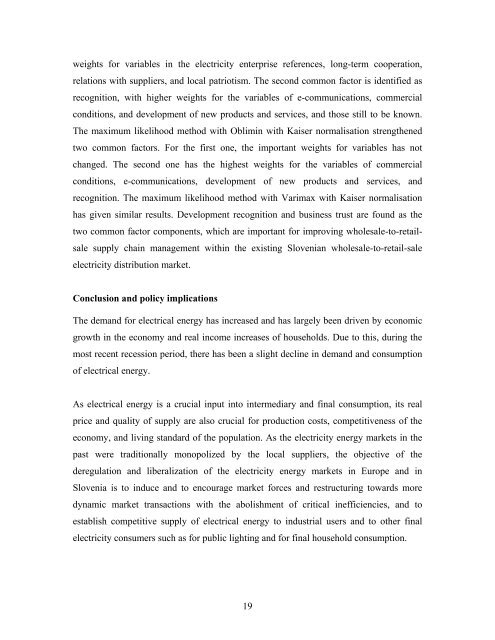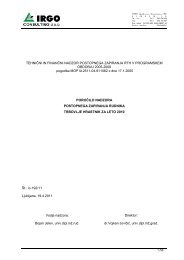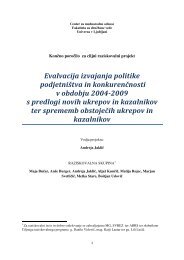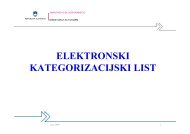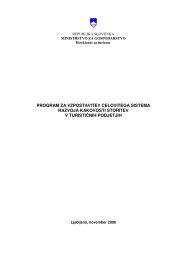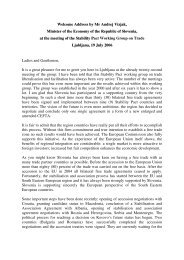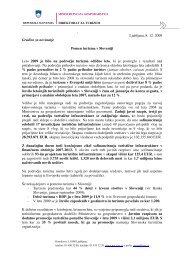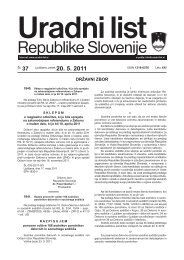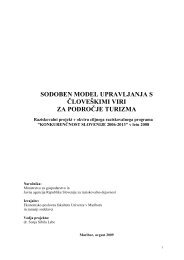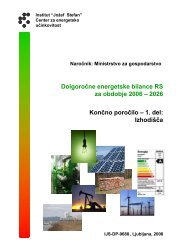Liberalisation of electricity market: the case of Slovenia
Liberalisation of electricity market: the case of Slovenia
Liberalisation of electricity market: the case of Slovenia
You also want an ePaper? Increase the reach of your titles
YUMPU automatically turns print PDFs into web optimized ePapers that Google loves.
weights for variables in <strong>the</strong> <strong>electricity</strong> enterprise references, long-term cooperation,relations with suppliers, and local patriotism. The second common factor is identified asrecognition, with higher weights for <strong>the</strong> variables <strong>of</strong> e-communications, commercialconditions, and development <strong>of</strong> new products and services, and those still to be known.The maximum likelihood method with Oblimin with Kaiser normalisation streng<strong>the</strong>nedtwo common factors. For <strong>the</strong> first one, <strong>the</strong> important weights for variables has notchanged. The second one has <strong>the</strong> highest weights for <strong>the</strong> variables <strong>of</strong> commercialconditions, e-communications, development <strong>of</strong> new products and services, andrecognition. The maximum likelihood method with Varimax with Kaiser normalisationhas given similar results. Development recognition and business trust are found as <strong>the</strong>two common factor components, which are important for improving wholesale-to-retailsalesupply chain management within <strong>the</strong> existing <strong>Slovenia</strong>n wholesale-to-retail-sale<strong>electricity</strong> distribution <strong>market</strong>.Conclusion and policy implicationsThe demand for electrical energy has increased and has largely been driven by economicgrowth in <strong>the</strong> economy and real income increases <strong>of</strong> households. Due to this, during <strong>the</strong>most recent recession period, <strong>the</strong>re has been a slight decline in demand and consumption<strong>of</strong> electrical energy.As electrical energy is a crucial input into intermediary and final consumption, its realprice and quality <strong>of</strong> supply are also crucial for production costs, competitiveness <strong>of</strong> <strong>the</strong>economy, and living standard <strong>of</strong> <strong>the</strong> population. As <strong>the</strong> <strong>electricity</strong> energy <strong>market</strong>s in <strong>the</strong>past were traditionally monopolized by <strong>the</strong> local suppliers, <strong>the</strong> objective <strong>of</strong> <strong>the</strong>deregulation and liberalization <strong>of</strong> <strong>the</strong> <strong>electricity</strong> energy <strong>market</strong>s in Europe and in<strong>Slovenia</strong> is to induce and to encourage <strong>market</strong> forces and restructuring towards moredynamic <strong>market</strong> transactions with <strong>the</strong> abolishment <strong>of</strong> critical inefficiencies, and toestablish competitive supply <strong>of</strong> electrical energy to industrial users and to o<strong>the</strong>r final<strong>electricity</strong> consumers such as for public lighting and for final household consumption.19


